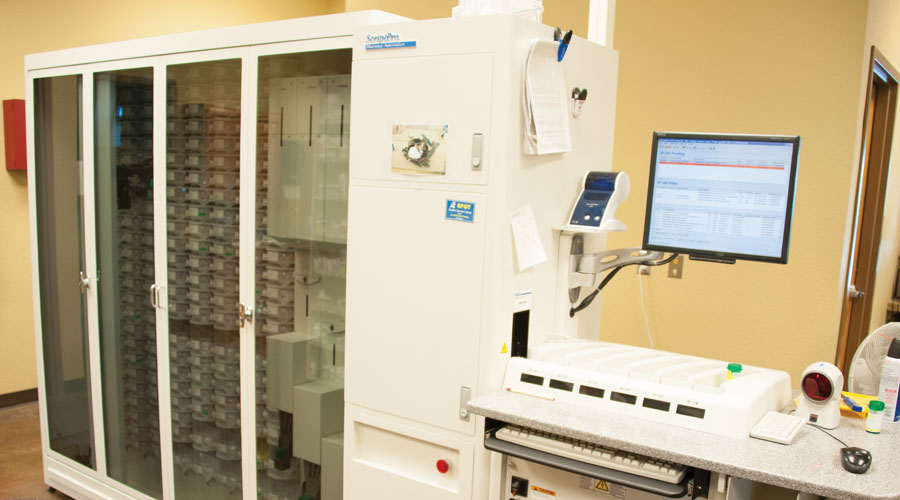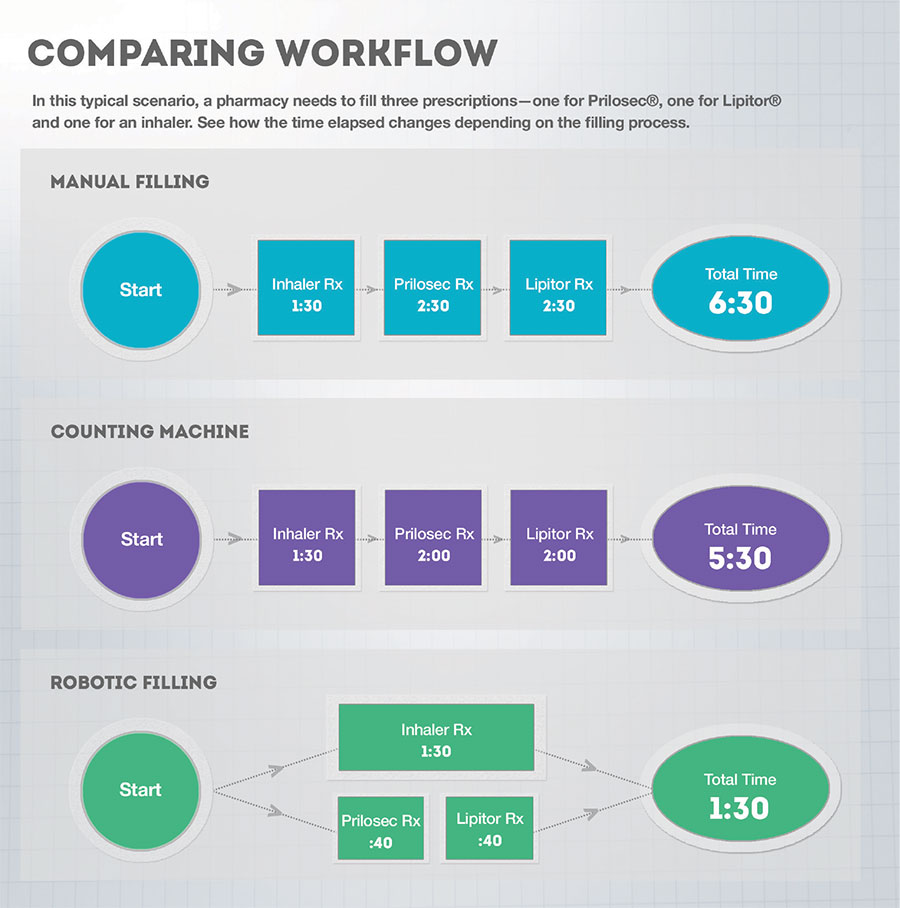Between filling scripts, counseling patients and providing additional services, independent community pharmacies often have more tasks than they can complete. But there are tools that can help your business by taking some of the work out of your hands—literally.
Adding robotics to your pharmacy is an investment worth considering. While pharmacy robots are nothing new, the reasons to add automation to your business have only increased. Patients now look to pharmacists for more than filling their prescriptions. Pharmacists today give immunizations; they counsel, recommend over-the-counter products and provide health screenings. As the role of the pharmacist evolves, so must your business.
“If you look across the spectrum of businesses in general—not just pharmacies—you see the importance of finding ways to automate, so people can focus on higher-level tasks,” said Mike Coughlin, president and CEO of ScriptPro, a company that develops robotics-based pharmacy management, workflow and telepharmacy systems.
According to the 2014 NCPA Digest, conducted by the National Community Pharmacists Association, only 25 percent of independent pharmacies have an automated dispensing system. If you’re operating without automation, maybe it’s time to take a look at your pharmacy and see if your business could benefit from investing in a robot. “If you’re not willing to take a hard look at how you run your business and make investments, then you’re not protecting your business and it will probably come back to haunt you,” Coughlin said.
Triggering events
Every pharmacy that believes in its future needs to invest in automation, Coughlin said, but how do you know when it’s the right time? There’s an easy way to find out. You’ll know you’re ready if you experience what Coughlin calls a “triggering event.”
Key triggering events for pharmacies include incidents like an increase in customer complaints due to long wait times, lost business because of inefficiencies in your system or key employees quitting. If a competing pharmacy closes and you know their patients will be coming to you, that’s also a triggering event.
Another gauge you can use to evaluate if you’re ready to add a robot is prescription volume. A significant increase in volume, or if you’re filling more than 150 prescriptions a day, indicates that you should consider investing in a robot.
Perhaps the most important triggering event is a dispensing error. Coughlin said he has had customers install a robot because they made a dispensing error and were looking for a way to ensure it would never happen again.
When a robot fills a prescription, it does everything from selecting the bottle to placing the label without human assistance. This virtually eliminates the chance for error in the dispensing process.
Initial challenges
Whether it’s the hefty start-up cost or the lack of floor space, there are many concerns that might cause a pharmacy to hesitate before installing a robot, but Coughlin said the most common cause is simply inertia.
It can be hard to change the system you’re used to, whether that’s manual dispensing or filling scripts with the assistance of a counting machine. But adjusting to a robotics system is worth the effort. It can boost your pharmacy’s efficiency and help you combat declining reimbursements and rising employment costs.
“When you’re running a business, you can either view challenges as things that are going to wreck your business or you can view challenges as opportunities to figure out a better way to run your business,” Coughlin said. “Those people who have viewed challenges as opportunities and figured out a better way to run their businesses have been successful. Those who have just kept doing what they’ve always done are finding that they’re getting worse and worse results.”
Before you buy
If you think it’s time to consider adding a robot to your pharmacy, the first thing you need to do is look around at the various sizes, functions and prices of the systems available. Coughlin suggests visiting pharmacies to ask current robotics customers about the quality of the machine. How easy is it to use? And, in particular, how easy is it to change the drugs dispensed? Also, ask about the quality and timeliness of the service and customer support they receive.
Pharmacies currently using a robot will also be able to give you a better idea about how different companies handle updates to their machines. Some robots become obsolete quickly. Others can be retrofitted with new hardware and software, so you can keep your robot up-to-date without purchasing a whole new system.
When looking at different systems, Coughlin warns that, like with most things, you can always get something cheaper, but paying a little more for a higher quality machine that won’t become obsolete might be worth it in the long run. Concerns about paying for the machine can often be addressed through financial modeling and analysis that take into consideration the financial returns of an automated system in comparison to your current system.
Integrating pharmacy
Coughlin said there are several reasons to make your pharmacy’s next hire a robot.
“It’s cheaper, faster and more reliably accurate to have a robot counting pills into a bottle and putting a label on it than it is to hire a person to come in and do that,” Coughlin said. “The robot is there 24/7. It doesn’t call in sick. It doesn’t take lunch breaks. It isn’t going to be interrupted.”
And, it improves workflow. “There’s a certain amount of chaos in a pharmacy that doesn’t have automation,” he said. “You’ve got pharmacists and techs running around, picking things up, getting interrupted and coming back and starting over. There are stock bottles, counting trays and labels sitting on the counter. The telephone is ringing. There are patients waiting, some of whom are getting impatient.”
“You put a robot in that same environment and all of a sudden the work just flows through quicker. Nobody has to tell the robot what to do. It automatically does the job.”
Looking forward
Adding automation will create time for you and your staff to focus on what’s important—your patients.
With a robot handling a good portion of the work, pharmacists and staff will have more time to go in the aisles and interact with patients. Focusing on patient care can translate to better medication outcomes and adherence, which results in healthier patients and, potentially, better Star Ratings for your pharmacy.
As pharmacies focus on serving their patients, they’ll be looked at as more of a source of health knowledge and less as a dispensary. “The pharmacy operators that are going to be successful in the future are going to be viewing it that way,” Coughlin said. “They’re not going to be seeing their role as glorified inventory control clerks, but as providers of knowledge.”
And robotics can help pharmacies in that role. Coughlin said current developments in robotics include improving adherence through different packaging methods, like the use of pouches that encourage compliance.
“What that robot is doing isn’t going to go out of style,” Coughlin said. “It’s here to stay.”













